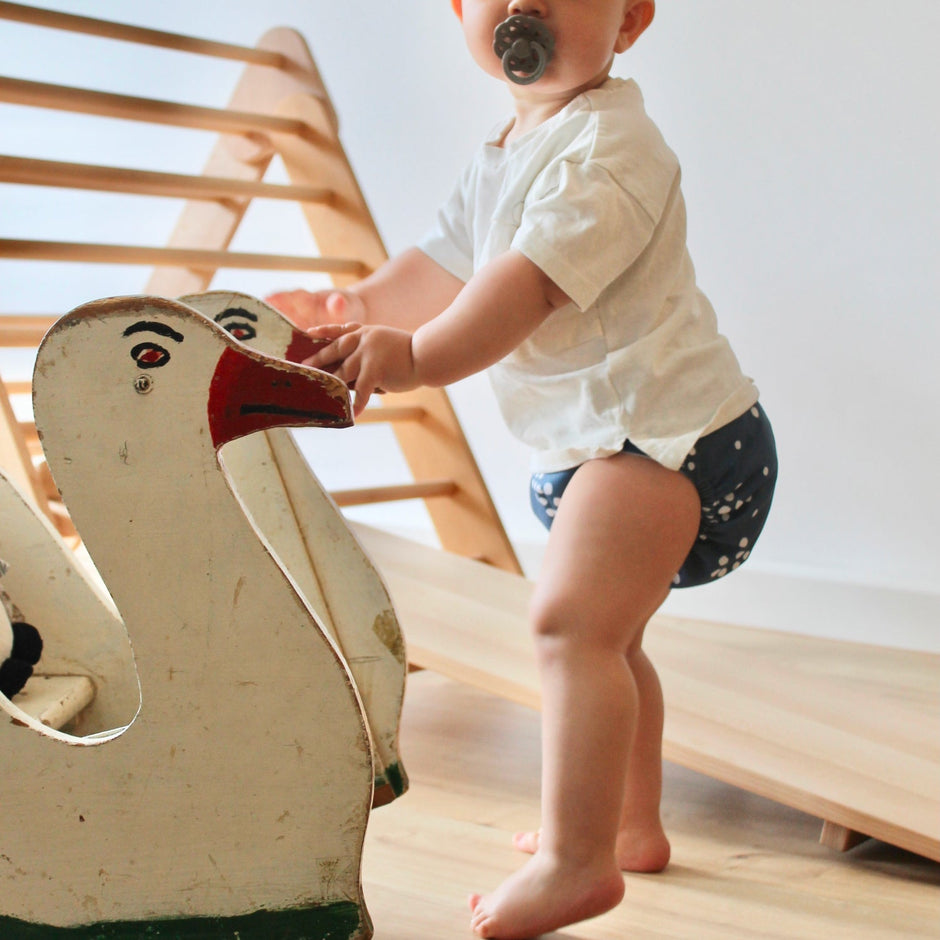Diapers in Kindergarten
Updated on:
Photo by @oliviafarjo
If your child starts kindergarten but still wears a diaper, that should not be a problem. But which diapers are suitable for daycare? Are caregivers allowed to refuse to change diapers? And how often are diapers changed in kindergarten? We have gathered all this important information for you.
Which diapers are suitable for kindergarten? Alongside disposable diapers, cloth diapers are also suitable for daycare, especially All-In-One diapers, All-In-Two diapers, and Judes cloth diapers.
In this article, you'll find all the information you need about diapering in daycare. Additionally, we provide helpful tips on how you and your child can prepare for diapering time in kindergarten.
Is my child allowed to attend kindergarten with diapers?
The short answer is: Yes, your child is allowed to attend kindergarten with diapers, as every child is entitled to a daycare place from the age of three (in Germany).
And here is the longer answer:
In Germany, your child does indeed have a right to daycare through a kindergarten or childminder, regardless of whether your child is potty trained or not. Nevertheless, your child can be rejected by a daycare center, as this legal entitlement is not mandatory for individual institutions. Each daycare center sets its own admission requirements.
This means that your child must definitely be given a place in childcare, but it may not be your preferred institution.
Do they change diapers at kindergarten?
If the kindergarten accepts your child knowing that they are not yet potty trained, they must be changed. Even if your child no longer wears diapers but occasionally has an accident, they are of course entitled to be changed.
Changing clothes and diapers must also be done in a designated area, because even small children have a right to privacy protection.

Photo by @isabelplett
Who is allowed to change my child's diaper?
In principle, all caregivers are allowed to change your child’s diaper. However, in the end, your child should be the one to decide who is permitted to change their diaper. The child's well-being is the top priority, and before your child is changed by anyone other than the parents, a relationship with that person should be established.
How can we establish diaper changing in kindergarten?
For your child to feel comfortable during diaper changes, they must get used to the new environment and build trust with the caregivers. Your child should only be changed by familiar people, and that doesn't happen overnight.
To help your child get used to the new surroundings, you should first change your child alone in the designated changing area the first few times. Next, the caregiver can join you to observe the changing routine. Do you have any special diapering rituals? Be sure to share those with the caregivers.
Perhaps the caregiver can help out next time, for example by handing you wet wipes, diapers, etc., or fastening the diaper.
Only when this trust has been established and your child agrees should the caregiver be allowed to change your child.
How often should diapers be changed in kindergarten?
Even in kindergarten, diapers should be changed at least every three to four hours. Of course, if there is a bowel movement, the diaper needs to be changed immediately.
In kindergarten, a full diaper may sometimes go unnoticed. In preparation for daycare, you could agree with your child (if you haven't already) that they should always let someone know when the diaper is full. Choose a word or a signal for this and communicate it to the caregivers. This way, your child doesn’t have to walk around with a full diaper longer than necessary.
What to do if caregivers do not change diapers regularly?
Even though it shouldn't happen, there are some daycare centers where caregivers change diapers too late, not regularly, or for example, only after a bowel movement. This can of course have negative effects on your child's well-being and can even lead to diaper rash.
It is important to find a quick solution here. You should definitely talk to the caregivers. Also discuss with your child that they should always let someone know (using the agreed word or signal) when the diaper is full. However, the responsibility naturally lies with the adults.
If these conversations do not lead to improvement, you should also talk to the other parents and, if necessary, seek a group conversation with the kindergarten management.
If all of this doesn't help, you should contact the facility’s operator. If that also does not lead to a solution, parents can contact the responsible municipal supervisory authority.
Which diapers are suitable for kindergarten?
Daycare diapers should definitely meet the following requirements:
The daycare diaper must be leakproof
The diaper should be able to absorb urine for several hours without leaking. This is often not the case with disposable diapers. Especially children who urinate in surges release large amounts at once, which disposable diapers may not be able to absorb quickly enough.
The daycare diaper should be comfortable
Your child should be able to feel comfortable and move freely in the diaper all day, without it slipping out of place. Make sure the diaper is the right size. It shouldn't be too tight, but it also shouldn't slip.
The daycare diaper should be uncomplicated
Caregivers have to change many diapers throughout the day. Often, time is limited in daycare centers. Therefore, the diaper should be as quick and easy to put on as possible. So be sure to choose the simplest possible diaper or cloth diaper option for daycare.
Are cloth diapers allowed in daycare?
Yes, cloth diapers are just as allowed in daycare and can be just as easy to use as disposable diapers.
Make sure that the cloth diaper meets the requirements mentioned above and explain in advance how the cloth diaper system works.
These cloth diapers are suitable for daycare use
There are several suitable cloth diaper systems that work well as daycare diapers. These include:
All-In-One Diapers (AIO)
With All-In-One diapers, the waterproof outer shell and the absorbent insert are sewn together.
Changing effort: Changing is very uncomplicated here → Lay the child on the diaper and fasten it, tuck the elastics into the leg crease
All-In-Two Diapers (AI2)
With All-In-Two diapers, the cover and inserts are not sewn together. The absorbent insert is snapped into the diaper or placed in the flaps.
Changing effort: Changing is very uncomplicated here → Lay the child on the diaper and fasten it, tuck the elastics into the leg crease
Judes cloth diapers
A Judes diaper consists of two combinable parts: the absorbent material (inner diaper) and a moisture barrier (cover). Thanks to its special weave, the cotton is particularly absorbent while the diaper remains very slim.
Changing effort: Changing is very uncomplicated here → Place the inner diaper and, if needed, Poo Paper (to catch the stool) into the cover. Lay the diaper under your baby’s bottom and close it with the hook-and-loop fastener.
By the way: Judes are not only great as daycare diapers; when combined with our Booster they are also ideal as a night diaper. This makes them a perfect all-rounder, and you won’t need to buy special daycare or night diapers.

Photo by @isabelplett
Preparing for diaper changes in kindergarten
To equip your child as best as possible for diaper changing in kindergarten, you can prepare together for everyday life at daycare in advance:
- As already mentioned, you can practice with your child letting you know as soon as the diaper is full. Agree on a specific word or signal that your child can use in daycare.
- It’s best to get information about the changing situation beforehand and perhaps have the changing area shown to you at the parents’ evening. That way, you can already explain to your child what to expect.
- If your child is to be changed with different diapers at daycare than at home, make sure to get them used to the new diapers ahead of time.
- Children are often changed while standing in kindergarten. You can also practice this beforehand.
Tips for diaper changing while standing
There are a few tricks to make diaper changes while standing much easier for you and your baby:
- Support for standing: To change your child while they are standing, you need both hands and ideally a bit of support using your knees or thighs. In other words: Your baby needs a secure and stable stand. This works best if they can hold on to something, such as the sofa armrest or a chair.
- Distraction: Chair and couch are not only useful as standing aids, but also as display shelves! Here you can place objects your baby can play with.
- Full body involvement: When you squat behind your baby to put on the diaper, it helps if you use a knee or thigh to hold the back part of the diaper against your baby's bottom. That way, your hands are free for the hook-and-loop fastener.
- Switching sides: Speaking of hook-and-loop fasteners: These are really advantageous for standing changes! You can first quickly secure one side and then the other in the front so the diaper stays on. Then you can calmly readjust it for a better fit.
- Teamwork: Especially older children can be great helpers during standing changes – it keeps them busy and distracted from fidgeting. For example, they can hold the front wings of the diaper while you fix the back part to their bottom.
How many diapers are needed for kindergarten?
In daycare centers, diapers are usually changed every three to four hours.
So, for the morning you should plan on two to three diapers (including the diaper put on at home). For full-day care, you’ll need about six to seven diapers to be on the safe side.
What diapering accessories do you need for daycare?
- Two wet bags → One bag for clean and one bag for used diapers
- Three to six diapers per day (plus maybe one or two as backup)
- Poo Paper
- Booster → If you are concerned about diapers not being changed often enough, you can increase absorbency with the booster
- Washcloths or wet wipes
- Spare clothes → in case a diaper does leak

Diaper-free in kindergarten
When should a child stop wearing diapers?
There is no set timeframe for when a child becomes potty trained. Every child is unique and every process of weaning off diapers is different. Some children are fully potty trained by age 2, others not until age 5, and both are completely normal.
→ Our own study shows that becoming diaper-free can happen faster: Children who were diapered with cloth diapers became diaper-free about 8 months earlier than those who wore disposable diapers.
When should a child go to kindergarten without a diaper?
If you are currently in the process of potty training and it’s already working well at home, the question arises: When can I send my child to kindergarten without a diaper?
As always, your child’s wishes should come first. Simply ask your child if they already feel ready to go to daycare without a diaper. Let them know they are free to change their mind at any time and that it’s not a problem at all if they have an accident.
Discuss with the caregivers how potty training is handled at the facility and simply try what works best for your child. The most important thing is: Everything should happen without pressure.
Definitely remember to pack enough spare clothes for your child.
Why isn’t my child potty trained in daycare?
It’s quite possible that your child is already (mostly) potty trained at home but still has “accidents” in daycare and just isn’t ready to go without a diaper there yet.
Kindergarten has a different atmosphere than home, and often children are too distracted to notice they need to go. Remember, every child is different and there is no fixed age for being fully potty trained.
Talk to the caregivers about your concerns. They have a lot of experience in this area and can reassure you.
Judes cloth diapers support potty training
By the way, Judes diapers can help your child become potty trained earlier. When you use cloth diapers for your child, they feel immediately when they wet their diaper. This gives them natural biofeedback. Through this immediate connection between action and result, even a baby can recognize the “if-then” relationship and gain an (unconscious) understanding of it.
This understanding benefits your child during the weaning off diapers process because they already recognize their body’s signals.
At Judes, we have intentionally designed our cloth diapers so that your baby feels wetness when they use the diaper. In this way, your baby can learn this important connection.
Here you will find more information about potty training and saying goodbye to diapers.
Toilet refusal syndrome
Of course, you should not ignore your child's signals. If your child was already mostly potty trained and suddenly refuses to use the toilet, preferring diapers again, this could be toilet refusal syndrome.
Definition: The toddler refuses for longer than one month to sit on the toilet to do their business, and prefers to use the diaper.
Toilet refusal syndrome can have physical causes such as constipation, or develop from a fear. If you suspect this is the case, definitely speak with your pediatrician to clarify the reason.
It’s important to understand that there’s no ill intent behind this refusal and that pressure will not lead to a solution.
I hope this article has answered all your questions about diaper changing in kindergarten and helped you choose the right daycare diaper. For more tips about cloth diapers be sure to follow us on Instagram.

Further questions and interesting facts
When should you start toilet training?
According to research, the ideal time for toilet training in most children seems to be between 22 and 30 months. However, every child is different, and you should pay particular attention to signs of your child’s readiness:
- Your child can sit independently and steadily
- Your child can walk (to the toilet)
- Your child imitates your behavior
- Your child notices/lets you know (by words or gestures) that there’s something in the diaper and wants to be changed
- Your child stays dry for a longer period (around 2 hours)
- Your child feels discomfort with dirty diapers
- Your child shows interest in the toilet and going potty
- Your child can follow simple instructions
When is a child considered potty trained?
Some say a child is potty trained when they have only one “accident” per week and can otherwise use the toilet independently. According to Elternkompass, a child is considered potty trained when they have more successful uses than “accidents.”

